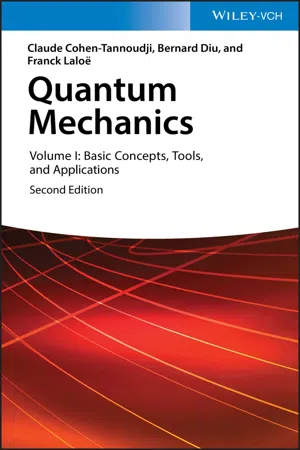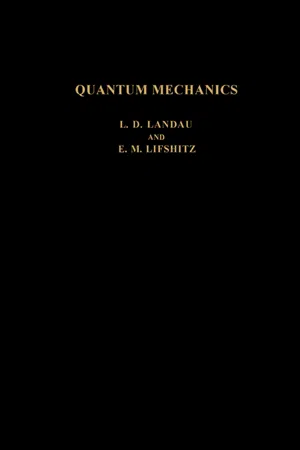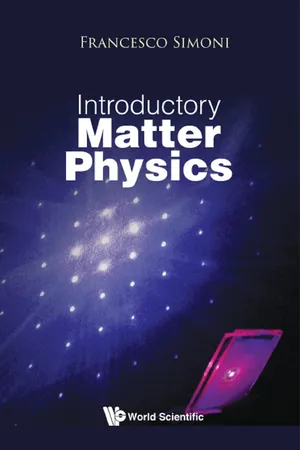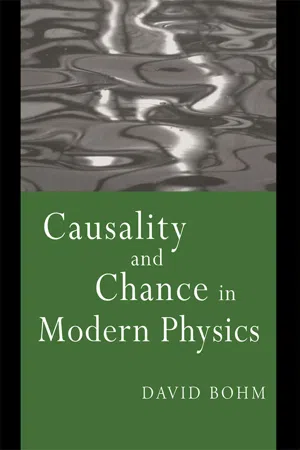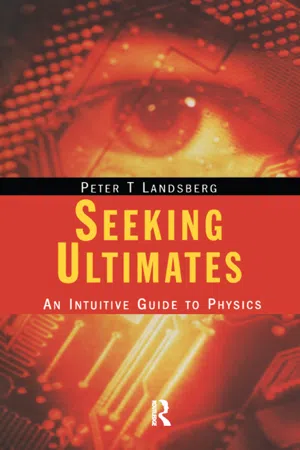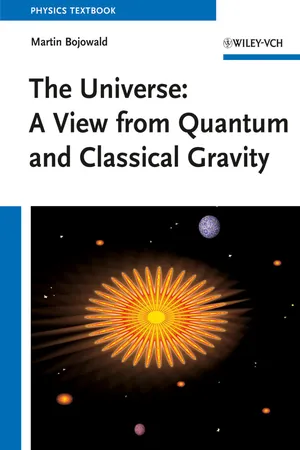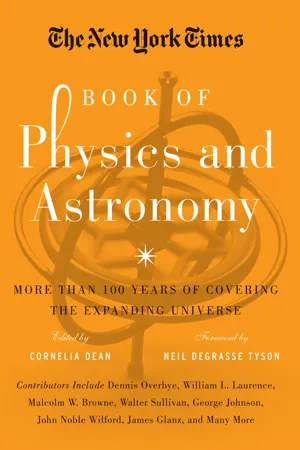Physics
Quantum Physics
Quantum physics is the branch of physics that deals with the behavior of particles at the atomic and subatomic levels. It describes the fundamental nature of energy and matter, incorporating principles such as wave-particle duality, superposition, and entanglement. Quantum physics has led to groundbreaking technologies like quantum computing and has revolutionized our understanding of the universe at its most fundamental level.
Written by Perlego with AI-assistance
Related key terms
Related key terms
1 of 4
Related key terms
1 of 3
9 Key excerpts on "Quantum Physics"
- eBook - ePub
Quantum Mechanics, Volume 1
Basic Concepts, Tools, and Applications
- Claude Cohen-Tannoudji, Bernard Diu, Franck Laloë(Authors)
- 2020(Publication Date)
- Wiley-VCH(Publisher)
Chapter I Waves and particles. Introduction to the fundamental ideas of quantum mechanics- A Electromagnetic waves and photons
- A-1 Light quanta and the Planck-Einstein relations
- A-2 Wave-particle duality
- A-3 The principle of spectral decomposition
- B Material particles and matter waves
- B-1 The de Broglie relations
- B-2 Wave functions. Schrödinger equation
- C Quantum description of a particle. Wave packets
- C-1 Free particle
- C-2 Form of the wave packet at a given time
- C-3 Heisenberg relations
- C-4 Time evolution of a free wave packet
- D Particle in a time-independent scalar potential
- D-1 Separation of variables. Stationary states
- D-2 One-dimensional “square” potentials. Qualitative study
In the present state of scientific knowledge, quantum mechanics plays a fundamental role in the description and understanding of natural phenomena. In fact, phenomena that occur on a very small (atomic or subatomic) scale cannot be explained outside the framework of Quantum Physics. For example, the existence and the properties of atoms, the chemical bond and the propagation of an electron in a crystal cannot be understood in terms of classical mechanics. Even when we are concerned only with macroscopic physical objects (that is, whose dimensions are comparable to those encountered in everyday life), it is necessary, in principle, to begin by studying the behavior of their various constituent atoms, ions, electrons, in order to arrive at a complete scientific description. Actually, there are many phenomena that reveal, on a macroscopic scale, the quantum behaviour of nature. It is in this sense that it can be said that quantum mechanics is the basis of our present understanding of all natural phenomena, including those traditionally treated in chemistry, biology, etc...From a historical point of view, quantum ideas contributed to a remarkable unification of the concepts of fundamental physics by treating material particles and radiation on the same footing. At the end of the nineteenth century, people distinguished between two entities in physical phenomena: matter and radiation. Completely different laws were used for each one. To predict the motion of material bodies, the laws of Newtonian mechanics (cf. Appendix III) were utilized. Their success, though of long standing, was none the less impressive. With regard to radiation, the theory of electromagnetism, thanks to the introduction of Maxwell’s equations, had produced a unified interpretation of a set of phenomena which had previously been considered as belonging to different domains: electricity, magnetism and optics. In particular, the electromagnetic theory of radiation had been spectacularly confirmed experimentally by the discovery of Hertzian waves. Finally, interactions between radiation and matter - eBook - ePub
The Language of Modern Physics
An Introduction to the Philosophy of Science
- Ernest H. Hutten(Author)
- 2022(Publication Date)
- Routledge(Publisher)
V Quantum Physics 1. Historical survey The discovery of the quantum of action in 1900 heralded a radically new departure in physics; it led in 1926 to the theory of quantum mechanics which was widely acclaimed as a revolution. Quantum theory has created a fundamental change in our ideas as relativity theory had done before. But while relativity theory is essentially classical in its conceptions—it is in fact the culmination of classical physics—quantum mechanics is founded on some new principles. The quantum laws are very different in character from the laws we find in classical theory. In particular, quantum mechanics is a strictly statistical type of theory : from this arises the different conception of causality that marks the new outlook of modern physics. The novel feature of this theory is that energy is regarded as existing in discrete amounts, i.e. quanta. Any given amount of energy may be thought of as an integral multiple of an isolated unit while, in classical physics, energy is something which varies in a continuous manner. And, from the logical viewpoint, the strange and ‘abstract’, not to say abstruse, nature of the new concepts made it necessary to be more critical about the construction of our theories; it resulted, ultimately, in a better understanding of all physics. Planck introduced the idea of a discrete quantum of energy in order to overcome the failure of the classical laws of radiation. Einstein, in 1905, extended this idea to the description of the phenomena of light; and he formulated his famous photon theory which, in a different form, re-created the corpuscular theory of light as held by Newton. Finally, basing his work upon the experimental research of Rutherford into the structure of the atom, Bohr in 1913 applied the conception of energy quanta to the emission and absorption of light by atoms. He invented a theory about the constitution of atoms which, immediately, led to great success - eBook - ePub
Quantum Mechanics
A Shorter Course of Theoretical Physics
- L D Landau, E. M. Lifshitz(Authors)
- 2013(Publication Date)
- Pergamon(Publisher)
CHAPTER 1THE BASIC CONCEPTS OF QUANTUM MECHANICS
Publisher Summary
This chapter discusses the basic concepts of quantum mechanics. The mechanics which governs atomic phenomena—quantum mechanics or wave mechanics—must be based on ideas of motion which are fundamentally different from those of classical mechanics. In quantum mechanics there is no such concept as the path of a particle. This forms the content of what is called the uncertainty principle, one of the fundamental principles of quantum mechanics, discovered by W. Heisenberg in 1927. In that it rejects the ordinary ideas of classical mechanics, the uncertainty principle might be said to be negative in content. This principle in itself does not suffice as a basis on which to construct a new mechanics of particles. Such a theory must naturally be founded on some positive assertions, which are also discussed in the chapter. However, in order to formulate these assertions, one must first ascertain the statement of the problems that confront quantum mechanics. To do so, the special nature of the interrelation between quantum mechanics and classical mechanics is examined. A more general theory can usually be formulated in a logically complete manner, independently of a less general theory which forms a limiting case of it. Thus, relativistic mechanics can be constructed on the basis of its own fundamental principles, without any reference to Newtonian mechanics.§1. The uncertainty principle
When we attempt to apply classical mechanics and electrodynamics to explain atomic phenomena, they lead to results which are in obvious conflict with experiment. This is very clearly seen from the contradiction obtained on applying ordinary electrodynamics to a model of an atom in which the electrons move round the nucleus in classical orbits. During such motion, as in any accelerated motion of charges, the electrons would have to emit electromagnetic waves continually. By this emission, the electrons would lose their energy, and this would eventually cause them to fall into the nucleus. Thus, according to classical electrodynamics, the atom would be unstable, which does not at all agree with reality. - eBook - ePub
- Francesco Simoni(Author)
- 2018(Publication Date)
- WSPC(Publisher)
Chapter 2
The Basics of Quantum Mechanics
2.1. The old quantum theory
We know that the physical sciences have been developing continuously since the setup of novel experimental methods paved the way for new research areas, and at the same time the theoretical explanation of physical phenomena has been pushing scientists to perform new experiments. For this reason, a good scientist should be ready to change his or her point of view concerning the interpretation of phenomena. Thanks to this open-mindedness, Galilei and Newton were able to change the approach to natural phenomena that had lasted many centuries since the time of the Greek philosophers. More recently, Planck, Einstein, Bohr, de Broglie, Heisenberg, Born, Dirac and many more clever scientists have been able to overcome the crisis of classical physics by developing the theory of quantum mechanics.The crisis occurred at the end of 1800 and the beginning of 1900, owing to a number of experimental facts which could not be explained following classical mechanics and classical electromagnetism. These experimental facts could fall neither into the frame of Newton’s mechanics nor into the frame of Maxwell’s equations. They made questionable the sharp border between the wave description of electromagnetic radiation and the corpuscular description of elementary particles.The main observations leading to the new point of view for the microscopic world concerned the light–matter interaction and the atomic structure.The explanation given by Max Planck for the spectrum of blackbody radiation is historically the beginning of this story, since he introduced for the first time the idea of the energy packet, opening the way to the concept of a quantum of energy, a basic one for the new theory. It is well known that all materials emit electromagnetic radiation with a spectral distribution dependent on the temperature of the emitting body. While at room temperature emission is usually in the infrared, by increasing the temperature to some hundreds of degrees Celsius emission is visible, giving rise to incandescence which occurs at a temperature dependent on the particular material. At the same time, the emitted power increases with temperature. This process can be studied by considering a hollow box with walls maintained at a constant temperature. The radiation inside the box is in thermal equilibrium with the walls and can be analyzed through a small hole that allows the exit of radiation. Since external radiation entering through the hole will be completely absorbed by the walls after a large number of reflections, the box is called a blackbody - eBook - ePub
- David Bohm(Author)
- 2004(Publication Date)
- Routledge(Publisher)
CHAPTER THREE: The Quantum Theory
1. INTRODUCTION
IN the previous chapter we have given a discussion on the evolution of classical physics, starting with Newton’s laws of motion, and continuing on to all the new developments which occurred up to the end of the nineteenth century. Throughout this time, however, the general philosophical view held by physicists was that of deterministic mechanism. For it was felt that even though the details of the theories that were then current would eventually have to undergo various modifications in response to the results of further experiments, the basic general scheme in which all theories are formulated in terms of differential equations determining the future behaviour of everything in the universe completely in terms of their states at a given instant of time would never have to be changed. For example, Lord Kelvin, one of the leading physicists of the time, expressed the opinion that the basic general outline of physical theories was pretty well settled, and that there remained only “two small clouds” on the horizon, namely, the negative results of the Michelson-Morley experiment and the failure of Rayleigh-Jeans law to predict the distribution of radiant energy in a black body. It must be admitted that Lord Kelvin knew how to choose his “clouds”, since these were precisely the two problems that eventually led to the revolutionary changes in the conceptual structure of physics that occurred in the twentieth century in connection with the theory of relativity and the quantum theory.Now, while the theory of relativity brought about important modifications in the specific forms in which the causal laws are expressed in physics, it did not go outside the previously existing theoretical scheme, in which the values of suitable parameters at a given instant of time would in principle determine the future behaviour of the universe for all time. We shall, therefore, not discuss the theory of relativity in this book, in which we are interested primarily in the question of causality, because this theory raised no question that went to the root of the problem of causality. - eBook - ePub
Applied Quantum Computers
Learn about the Concept, Architecture, Tools, and Adoption Strategies for Quantum Computing and Artificial Intelligence (English Edition)
- Dr. Patanjali Kashyap(Author)
- 2023(Publication Date)
- BPB Publications(Publisher)
Any nonzero quantity of coherence in a system can be transformed into an equivalent volume of entanglement among that system and another initially incoherent one. This detection of the change among coherence and entanglement has numerous significant consequences. For example, it means that quantum coherence can be restrained through entanglement. Thus, all of the inclusive knowledge that investigators have got regarding entanglement can now be directly useful to coherence, which in over-all is not as well-researched. For instance, the new facts have now allowed for the physicists to settle a significant open question regarding the geometric quantity of coherence.Before Quantum Physics, there is no law… right …!!!
Wrong. Earlier, Isaac Newton (1642–1727) had sketched, in influential mathematical features, what turns out to be recognized as classical or Newtonian mechanics. It comprises Laws of Motion and Universal Law of Gravitation, which are used to compute the forces that are applicable on all objects we see from one place to another. These laws and theories describe the way those objects move. Everything from falling rivers to the paths of the Mangal Yan satellites comes under its arena. Newton’s body of work, composed with the explanations and careful experiments of others before him, such as Galileo, had set the scene for the hulks of nineteenth-century physics, and a few others like Michael Faraday and James Clerk Maxwell, to complete the depiction of classical physics.The definition of quantum computers … revisited
A quantum computer is a physical device that critically exploits delicate quantum properties, and whose normal progression over time can be understood as the accomplishment of an anticipated and governable calculation.Strangely, computer science forecasts that quantum computers will be intelligent enough to do certain computational tasks in remarkably fewer steps than any classical computer. Furthermore, quantum properties permit extraordinary errands to be achieved, such as teleporting quantum information, cracking unbreakable codes, producing truly random numbers, and communicating with letters that depict the occurrence of snooping. These abilities are of noteworthy applied importance to banks and government agencies. It is worth noting here that these are not distinct dreams. For instance, a quantum arrangement for transfer and getting ultra-secure information has now been realized. - eBook - ePub
Seeking Ultimates
An Intuitive Guide to Physics, Second Edition
- Peter T. Landsberg(Author)
- 2019(Publication Date)
- CRC Press(Publisher)
They refer not to the behaviour of physical systems, but to the way we learn about, interpret and understand this behaviour. They refer not to physics, not to properties of quantum mechanics, but to properties of our brains. They are not physics, but psychology—too often abnormal psychology [ 6.23 ]. (iii) Quantum mechanics can be understood….[those] writing for the general public do a disservice to science by clothing quantum mechanics in a mystical aura. It is a perfectly logical, coherent physical theory, which can be understood rationally. The mysticism is theirs [ 6.24 ]. Here is what a great physicist (Richard Feynman) is supposed to have said: ‘Don’t try to understand quantum mechanics or you will fall into a black hole and never be heard of again’. Nowadays we can do rather better than that! 6.8 Quantum effects We now come to some important specific and unexpected effects which can be linked to quantum theory. 6.8.1 Black-body radiation An ideal gas is defined to be one in which intermolecular forces are small, as they would be in the dilute gases introduced on p 11. While a theoretical fiction, it is a very useful one, particularly if you wish to make some simple calculations of gas properties. It will be understood that with millions and millions of particles in just one millimetre cube, if every particle feels a force due to every other particle, calculations regarding a real gas (i.e. one with reasonably strong inter-particle interactions) are impossible to do exactly. Another important ideal system occurs if we construct a box with apparently nothing in it. It has to contain the radiation emitted by the sides of the box and if that is in equilibrium with the box, then, by the definition of thermal equilibrium, that radiation will be at the same temperature as the box. Scientists speak of radiation, or, which is the same thing, of light, as consisting of photons. These are packets of energy which can come in all colours - eBook - ePub
The Universe
A View from Classical and Quantum Gravity
- Martin Bojowald(Author)
- 2012(Publication Date)
- Wiley-VCH(Publisher)
Chapter 4
Quantum Physics
Scientists observe nature and try to predict new phenomena from what is known. The notion of observations, even if they are not actively done, is the primary concept; it determines what kind of predictions and theories are possible. Relativity takes seriously the notion that physics can at best describe what a single observer, or perhaps a community of communicating observers, detect and measure. Observers positioned differently or moving in various ways may not measure the same numbers even if they observe the same situation, but their measurement results can be translated into one another. Physics is not solipsistic; on the contrary, it is important to compare what different observers see in order to confirm results by independent means. By considering a large class of observations, done in different ways and from different viewpoints, a great deal of information about nature can be gained. However, even if one uses the collective data of all possible observers, there cannot be an all-knowing entity in physics with access to everything that happens in the universe at a given moment in time. At any moment, we can only know what we have experienced (and remember) or has been communicated to us. Since the number of observations we can make in the finite span of life is limited, and the speed of communication cannot exceed the speed of light, it is not possible for us to gain information about everything that happens at some time.One may compare the transition from Newtonian physics, where, at least in principle, an all-knowing observer might exist, to relativity theory by the literary transition from an epos to a novel told by a participating hero. An epos is written from the perspective of a watchful author aware of a multitude of simultaneous actions. A novel told by a participating hero can only refer to what the hero knows, even if the author has the whole story plotted out. The prevailing form of Newtonian physics is an epos in which the physicist describes the motion and collisions of different bodies. The heroes of Newtonian physics are lifeless objects such as the planets, stars or galaxies moving and interacting in epic fashion. The heroes of relativity are observers, who experience the motion of objects and communicate with other observers as the story unfolds. - eBook - ePub
The New York Times Book of Physics and Astronomy
More Than 100 Years of Covering the Expanding Universe
- Cornelia Dean(Author)
- 2013(Publication Date)
- Union Square & Co.(Publisher)
Physicists have tried to discourage mystics by emphasizing that the observer need not be a conscious being: An electronic detector or a photographic plate will do. It is the collision with the rock-solid world that resolves the particle’s ambiguous existence.But many physicists find this explanation dissatisfying. They would like quantum mechanics to be a completely self-contained theory, with no need to invoke any kind of outside measurer.After all, if quantum mechanics is taken to its logical extreme, the universe itself can be described by a wave function, all its possible histories hovering together in superposition. By definition, there can be nothing outside the universe, no external observer or measurer to conjure up this particular universe from the plentitude of possibilities.Maybe all it takes to collapse the wave function, Dr. Zurek and his colleagues propose, is for a particle to undergo some kind of tiny disturbance, to come into contact with other particles. The delicately balanced superposition in which all the possibilities stick together, or “cohere,” would come unglued. It would “decohere.” Then the particle could assume a particular position.Or, as Dr. Zurek has described it, “the watchful eye of the environment”—the particles and waves that pervade creation—is constantly making measurements, banishing quantum ambiguity and conjuring up hard-edged reality, the familiar world dominated by the commonsensical laws of classical physics.There would be no need for a curious observer or even a measuring instrument to solidify Einstein’s moon or to put Dr. Zurek’s Coke bottle on one side of the table or another. The decoherence caused by the jiggling of an object’s own atoms and the particles around it would be enough.To dramatize the problems of applying quantum theory to the classical world, the Austrian physicist Erwin Schrödinger devised his famous thought experiment in which the fate of a cat is tied to that of a single subatomic particle. In one version, a photon (a particle of light) is fired at a half-silvered mirror, giving it a 50-50 chance of reflecting back or sailing through. If the photon passes through the mirror, it strikes a photoelectric detector, activating a circuit that breaks a vial of poison and kills the cat. If the photon is reflected away from the detector, the cat is spared.
Index pages curate the most relevant extracts from our library of academic textbooks. They’ve been created using an in-house natural language model (NLM), each adding context and meaning to key research topics.
Explore more topic indexes
Explore more topic indexes
1 of 6
Explore more topic indexes
1 of 4
